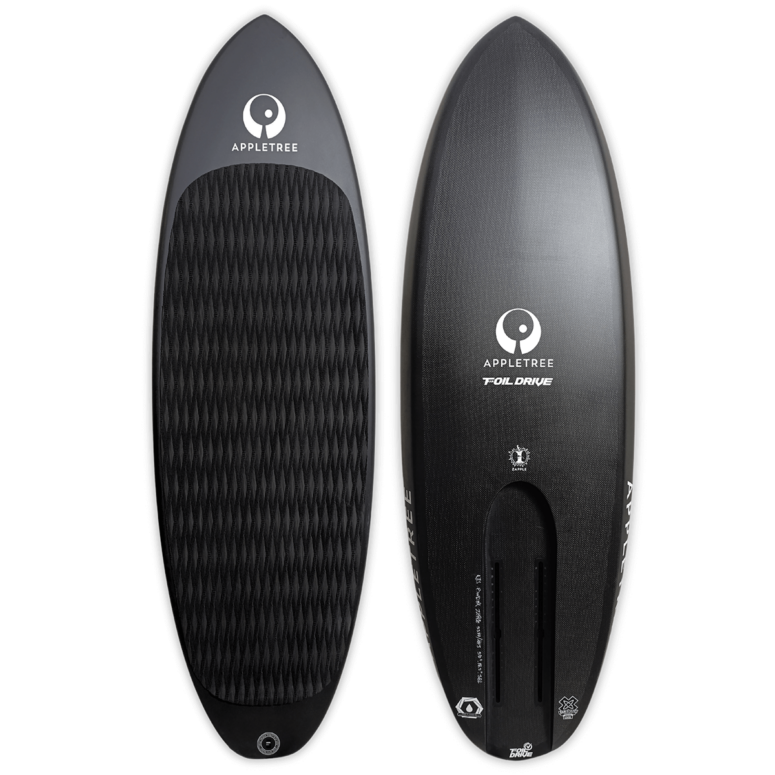

When you purchase gear through links on our site, we may earn a small commission. Here’s why you can trust our tests and our affiliate partner.

With the foil assist revolution well and truly upon us, it makes sense that board design augments itself to currently available equipment, and with Foil Drive the widest adopted system, various garage tinkerers have integrated the battery into some sort of recess in the board. This is a prime example of where having your own factory and being able to respond quickly to market demand is a massive advantage in the quick moving industry. After some ahead-of-the-curve prototyping and testing, and close work with Foil Drive, who are never shy to collaborate, Appletree have got a board produced in the form of the Zapple. Three stock sizes are available in 38, 46 and 54 liters. If you were going to describe the shape, it’s probably closest to a slender mid-length, with narrow widths between 18.5 and 19.5 inches, and elegant drawn-out lengths between 5’0 and 5’8. The board retains plenty of flat section in the rear quarters providing that all important planing surface, and a spine runs into a smooth and purposeful looking nose.
The inset trench design makes sense at several levels. Bringing the mass of the battery up closer to your feet makes it far more instant to initiate directional changes, and gives you a hell of a lot more foil feeling. There’s only 15mm of material between you and the drive unit rather than several inches in most cases on a non-inset board. From a riding feeling perspective, the whole rig feels far more cohesive as one unit, rather than feeling like you’re perched on top of it all. The mass of the battery is instantly controllable, you can change direction more quickly and therefore drives a far smoother turn.
Sinking that unit into the board also means you lose the drag from the battery box. On a standard board, if you dip the motor pod whilst riding, you get a warning shot to adjust your pitch higher, and then if the battery box contacts the surface it’s usually difficult to recover and it’s normally game over. With an inset board you’ll find this isn’t a problem. It’s worth bearing in mind that your motor will now be 50mm closer to your board also, although due to the recess you can’t catch the battery housing anymore. We found 15cm cable length still about right for the majority of conditions for ‘motor out’ prone use, even if it was a little choppy. The nose design of this board shines in the chop also, and glances off the water well without the slap of a flatter surface, this is particularly significant if you’re running a shorter cable.
Another benefit of recessing the unit is simply in takeoff. Negating the drag of the battery box means you’ll need less power to take off on equivalent foil sizes. It’s simply much easier to get up on foil. This increase in efficiency, crucially where your system is burning the most power, also means less strain on the battery and therefore longer battery durations. The other added benefit of this is obviously being able to drop foil sizes. As soon as the swell is more consequential, it’s a game of how small a foil is it possible to ride to maximize performance. The Zapple let me drop down a front wing size instantly.
Probably the only sticking point with the trench system is when it comes to battery swaps – there’s no avoiding the fact you need to remove the whole unit from the trench to undo the clips and release the nose cone. Frankly, when you weigh up undoing four bolts (probably an extra 30 seconds) versus the substantial performance advantages, it’s a no brainer for us. After an hour plus of riding, it’s quite nice to have a breather, perhaps tune your setup for changing conditions. Some solutions with barrel bolts will be available to keep things flush and make the process as easy as possible and we found bolting (or 3M VHB taping) the unit to the mast made things even easier.
From testing a few different trench board incarnations, what’s essential is maintaining stiffness between the front and rear foot placement; as you’ve removed a lot of material for the trench, it’s not a simple board design to engineer or mass produce. Appletree’s vacuum-infused carbon boards are notoriously stiff and this carries over well into the Zapple. Signal consistency has always been a query with full carbon boards, so Appletree have made a cunning window of normal glass in the nose of the deck to keep this consistent. The track is also long enough to allow for some adjustability in foil position, which is key to a well-balanced ride. We tested across AXIS, Armstrong and Code systems with nothing but positive results.
It’s a testament to how established a discipline has come in the space of a year that manufacturers are now producing dedicated boards, and it’s undeniable that the Zapple makes riding a foil assist even closer in feeling response to normal prone foiling, as well as improving efficiency and battery life. For the dedicated Foil Drive user, this is an essential piece of equipment, that makes a significant improvement to the ride.
